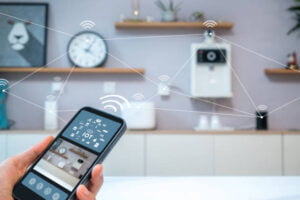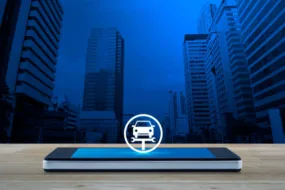Smart device integration:

Ever wish your home could take care of itself? With the rise of smart devices, that dream is becoming a reality. From smart lights to robot vacuums, these devices can automate repetitive tasks and offer unprecedented levels of convenience. But did you know that smart device integration can also save you valuable time and money?
This blog post explores the exciting world of smart device integration and explains how it can benefit your daily life. We’ll delve into several ways integration streamlines your routine and reduces household expenses.
What is Smart Device Integration?
Imagine having a single app or platform that controls all your smart devices. That’s the magic of smart device integration. It allows you to connect and orchestrate different smart devices from various brands, creating a unified system that works seamlessly together.
Benefits of Smart Device Integration:
1. Unleash the Power of Automation:
One of the most significant advantages of integration is automation. By setting up routines and schedules, you can eliminate the need to manually control your devices. Here are some examples:
i. Automated Lighting: Set your smart lights to turn on at sunset and dim gradually at bedtime, creating a warm and welcoming ambience while saving energy.
ii. Smart Thermostat Control: Programme your thermostat to adjust automatically based on weather conditions and your preferred temperature settings, ensuring maximum comfort without wasting energy.
iii. Schedule Your Cleaning: Schedule your robot vacuum cleaner to clean your floors while you’re at work or asleep, freeing up precious time for other activities.
2. Streamline Your Daily Routines:
Imagine saying “good morning” to your smart speaker and having your lights turn on, coffee start brewing, and your favourite news programme play. With integration, creating custom routines becomes a breeze. You can automate various aspects of your daily life, from turning off lights when leaving the house to preheating the oven before dinner.
3. Enhanced Convenience:
Imagine controlling your entire home with just your voice or smartphone. Integration allows you to adjust lighting, lock doors, monitor security cameras, and even control your entertainment system from anywhere, anytime. This level of control translates to exceptional convenience, making your life easier and more manageable.
4. Increased Security:
Integrated smart security systems offer enhanced home security. You can receive real-time alerts if your doors or windows are opened, monitor your home remotely with smart cameras, and even set up automated responses to suspicious activity. This peace of mind is invaluable when it comes to feeling safe and secure in your own home.
5. Energy Efficiency and Cost Savings:
Here’s where smart device integration shines. By automating lighting, temperature control, and other energy-consuming functionalities, you can significantly reduce your energy consumption. This translates to lower utility bills and a positive impact on the environment.
Read More: How AR Remote Assistance Can Save You Time and Money
How Does Smart Device Integration Save You Money?

Now, let’s dive deeper into how integration can save you money:
i. Reduced Energy Consumption: As mentioned earlier, automated controls for lighting, heating, and cooling can significantly reduce energy waste. This translates to lower energy bills and potential savings on your monthly expenses.
ii. Eliminate Standby Power: Many electronics continue to draw power even when not actively used. The integration allows you to schedule smart outlets to power off devices when not in use, eliminating unnecessary energy consumption and saving you money on your electricity bill.
iii. Leak Detection and Prevention: Smart water sensors can detect and alert you to potential leaks in your plumbing system before they cause significant damage. This early detection can save you from costly repairs and water damage restoration expenses.
iv. Improved Security: Integrated smart security systems can deter potential break-ins and provide valuable evidence in the event of an incident. Additionally, some insurance companies offer discounts for homeowners with smart security systems, further reducing your overall security costs.
Getting Started with Smart Device Integration:
While the initial setup might require some investment and research, the long-term benefits outweigh the initial costs. Here are some tips for getting started:
i. Identify Your Needs: Before investing in smart devices, consider your specific needs and priorities. Do you prioritise convenience, security, or energy efficiency? Identifying your needs helps you choose the right devices and sets the stage for successful integration.
ii. Research Compatibility: Ensure the smart devices you purchase are compatible with your chosen platform or hub for seamless integration.
iii. Start Small: Don’t overwhelm yourself; start with a few key devices and gradually expand your smart home ecosystem as you gain experience and confidence.
iv. Seek Guidance: Don’t hesitate to seek guidance from professionals or online resources to help you choose compatible devices and set up your system.
Beyond the Savings:
While the cost-saving benefits are undeniably attractive, it’s important to remember that smart device integration offers much more than just financial advantages. Integration can significantly improve your quality of life by:
i. Reducing Stress: Automated routines and remote control capabilities can significantly reduce the mental burden of managing your home, freeing you up to focus on other priorities.
ii. Enhancing Comfort: Creating a personalised home environment with automated lighting, temperature control, and entertainment systems can significantly improve your overall comfort level.
iii. Promoting Peace of Mind: Knowing your home is secure and functioning properly, even when you’re away, can provide immense peace of mind.
iv. Encouraging Sustainable Living: By minimising energy consumption and promoting responsible resource usage, smart home integration can contribute to a more sustainable lifestyle.
Read More: Unveiling IoT Applications in Smart Grids
Challenges to Consider for Effective Smart Device Integration:

While smart device integration offers a plethora of benefits, there are also some key challenges to consider for effective integration:
1. Compatibility and Interoperability:
i. Limited compatibility: Not all smart devices are compatible with each other, and some require specific platforms or hubs to function together. This can lead to frustration and limit the functionality of your integrated system.
ii. Evolving standards: The smart home industry is constantly evolving, leading to updates and changes in standards. Keeping your devices and systems up-to-date can be challenging and requires continuous monitoring.
2. Security Concerns:
i. Cybersecurity vulnerabilities: Integrating various devices can create more entry points for potential cyberattacks. Ensuring robust security measures and keeping software and firmware updated is crucial to protecting your privacy and securing your smart home.
ii. Data privacy concerns: Smart devices collect data about your usage patterns and daily routines. It’s essential to be aware of data collection practices and choose devices with strong data security measures in place.
3. Complexity and Cost:
i. Initial investment: Setting up a smart home requires an initial investment in purchasing compatible devices, hubs, and potentially professional installation services. This can be particularly daunting for budget-conscious individuals.
ii. Learning curve: Understanding device functionalities, setting up apps, and configuring routines can be overwhelming for some users, especially those less comfortable with technology.
4. Reliability and Dependence:
i. Technical glitches and outages: Like any technology, smart devices can experience malfunctions, network outages, or bugs. Overdependence on automation can be disruptive if such issues occur.
ii. Limited functionality: Not all traditional functionalities can be easily replicated through smart devices. It’s essential to manage expectations and acknowledge that smart home integration might not completely replace manual interactions in every scenario.
5. Environmental Impact:
i. E-waste generation: Disposing of outdated and non-functional smart devices can contribute to the growing problem of electronic waste (e-waste) if not properly managed and recycled.
ii. Environmental impact of manufacturing: Producing and manufacturing smart devices requires resources and energy, contributing to the environmental footprint. It’s essential to analyse the environmental impact of smart home technology alongside its benefits.
By being aware of these challenges and taking steps to mitigate them, you can maximise the benefits of smart device integration and create a smarter, more efficient, and more comfortable home.
Conclusion:
Smart device integration is no longer a futuristic fantasy; it’s becoming a reality for many households. While the initial investment might seem daunting, the long-term benefits outweigh the costs. From saving time and money to improving comfort and security, integration has the potential to transform your home into a haven of convenience and efficiency.
So, are you ready to unlock the potential of smart device integration? Do some research, prioritise your needs, and start your journey towards a smarter, more connected home. Remember, even small steps can lead to significant improvements in your daily life and your household expenses.










